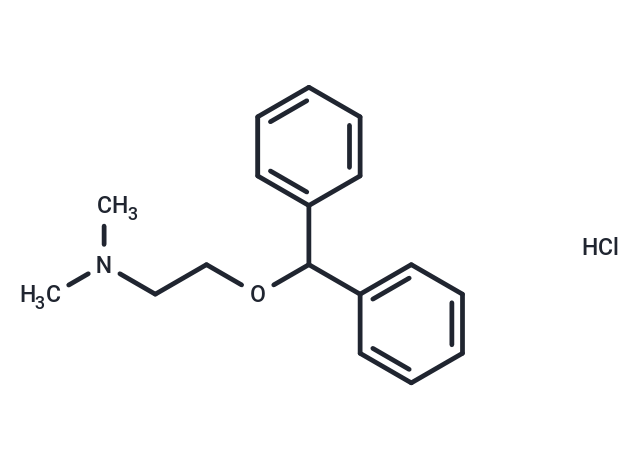Shopping Cart
- Remove All
 Your shopping cart is currently empty
Your shopping cart is currently empty

Diphenhydramine hydrochloride (DPH) is a histamine H1 antagonist used as an antitussive and antiemetic. It is also used for pruritus and dermatoses, for hypersensitivity reactions, as an antiparkinson, a hypnotic, and as an ingredient in common cold preparations.

| Pack Size | Price | Availability | Quantity |
|---|---|---|---|
| 200 mg | $29 | In Stock | |
| 1 mL x 10 mM (in DMSO) | $44 | In Stock |
| Description | Diphenhydramine hydrochloride (DPH) is a histamine H1 antagonist used as an antitussive and antiemetic. It is also used for pruritus and dermatoses, for hypersensitivity reactions, as an antiparkinson, a hypnotic, and as an ingredient in common cold preparations. |
| In vitro | Diphenhydramine blocks tetrodotoxin-sensitive (TTX-S) and tetrodotoxin-resistant (TTX-R) sodium currents with K(d) values of 48 mM and 86 mM, respectively, at a holding potential of -80 mV. Diphenhydramine shifts the conductance-voltage curve for TTX-S sodium currents in the depolarizing direction but has little effect on that for TTX-R sodium currents. Diphenhydramine causes a shift of the steady-state inactivation curve for both types of sodium currents in the hyperpolarizing direction. Diphenhydramine produces a profound use-dependent block when the cells are repeatedly stimulated with high-frequency depolarizing pulses. [1] Diphenhydramine induces apoptosis in a dose- and time-dependent manner in both CCRF-CEM and Jurkat cell lines, whereas Cimetidine fails to induce significant effects at similar concentrations. Diphenhydramine-induced apoptosis is evaluated in terms of morphology, flow cytometry, and the release of cytochrome c to the cytosol. Diphenhydramine inhibits cell proliferation without inducing apoptosis in human peripheral blood mononuclear cells. [2] Diphenhydramine (500 nM) significantly reduces the baseline firing of the periaqueductal gray neurons without a significant effect on the frequency of postsynaptic potentials. Diphenhydramine at high concentration inhibits periaqueductal gray neurons, but at low concentrations it has no effect on the baseline-firing rate and it blocks the response to neurotensin and tomedial preoptic nucleus stimulation. [3] |
| Alias | DPH, Diphenhydramine HCl |
| Molecular Weight | 291.82 |
| Formula | C17H22ClNO |
| Cas No. | 147-24-0 |
| Smiles | CN(CCOC(c1ccccc1)c1ccccc1)C.Cl |
| Relative Density. | 1.0489 g/cm3 (Estimated) |
| Storage | Powder: -20°C for 3 years | In solvent: -80°C for 1 year | Shipping with blue ice. | |||||||||||||||||||||||||||||||||||
| Solubility Information | DMSO: 45 mg/mL (154.2 mM), Sonication and heating are recommended. | |||||||||||||||||||||||||||||||||||
Solution Preparation Table | ||||||||||||||||||||||||||||||||||||
DMSO
| ||||||||||||||||||||||||||||||||||||

Copyright © 2015-2025 TargetMol Chemicals Inc. All Rights Reserved.